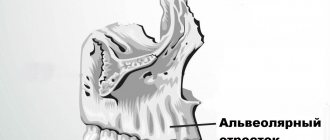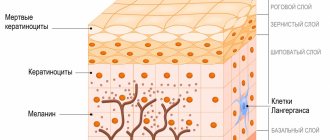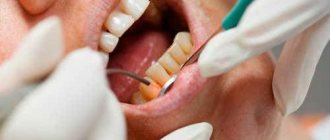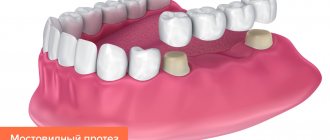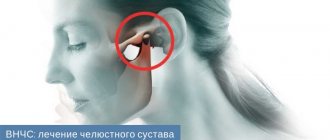There are many types of jaw bandages, and they can be made by hand or sold ready-made
When the lower jaw is damaged, it is often necessary to make the moving parts immobile. For this, the only way out is to use bandages. The sling bandage for the jaw is easy to make and use.
Algorithm for applying a sling-shaped bandage to the chin.
Indications:
wounds, burns, fixation of bandages after surgery, trauma to the lower jaw.
1. Sit the patient down and calm him down.
2. Explain the course of the upcoming manipulation.
3. Cut a strip 75-90 cm long from a 20 cm wide bandage.
4. Fold the bandage strip in half.
5. Roll the ends of the bandage strip towards the middle (the middle is 20 cm long).
6. Cut the ends of the bandage strip lengthwise to the middle.
7. Place the middle of the sling on the chin area.
8. Cross the cut ends:
· Raise the bottom ties vertically up in front of the ears to the crown of the head and tie with a knot;
· Lower the top ties, guide along the lower jaw to the back of the head and tie with a knot.
Algorithm for applying a bandage to one ear.
Indications
: postoperative condition, middle ear disease.
1. Make the patient sit facing you, calm him down, and explain the course of the upcoming manipulation.
2. Take the beginning of the bandage in your left hand, the head of the bandage in your right.
3. Apply a bandage to the frontal part of the head.
4. Bandage the left ear from right to left, the right ear from left to right.
5. Make two securing bandages around the frontal and occipital areas of the head.
6. Lower the bandage from the frontal area of the head to the upper part of the auricle.
7. Make a securing bandage through the frontal and occipital areas of the head.
8. Secure the bandage by cutting the end of the bandage and tying it to a knot on the frontal part of the head.
Algori bandages
One finger.
1. Make two securing rounds of bandage around the wrist joint.
2. Place the bandage from the wrist joint along the back of the hand along the injured finger.
3. Go around the tip of the finger, carry the bandage from the palmar surface to the base of the finger, then from the palmar surface through the tip of the finger to the base on the back surface of the hand. With a hand free from the bandage, hold the bandage on the palmar surface of the patient’s hand.
4. Bandage with a creeping type from the base to the tip of the finger, then in a spiral manner - from the tip of the finger to the base.
5. Transfer the bandage through the back of the hand to the wrist joint (at the base of the finger - transfer to the hand in a crosswise manner).
6. Secure the bandage on the wrist joint with two fastening rounds.
7. Cut the end of the bandage and tie it in a knot.
Finger pressure of the artery throughout.
Pressing the artery along its length, i.e. above the wound (closer to the heart), based on the fact that some arteries are accessible to palpation and their lumen can be completely blocked to the underlying bone formations. This method is advantageous in that it is technically simple, does not infect the wound, and provides sufficient time to prepare everything necessary to use a more convenient method of stopping bleeding - a pressure bandage, a tourniquet, or a twist.
You can press the artery with your finger, palm, or fist.
Algorithm for digital compression of the temporal artery.
1. Make the patient sit facing you.
2. Calm him down.
3. Press the temporal artery above the tragus of the ear to the temporal bone.
Algorithm for digital compression of the maxillary artery.
1. Place the patient on his back.
2. Reassure the patient.
3. The external maxillary artery is pressed against the lower jaw at the border of its middle and posterior third.
Algorithm for digital compression of the brachial artery.
1. Make the patient sit facing you.
2. Calm him down.
3. When bleeding from the lower and middle third and forearm, the brachial artery is pressed against the humerus at the inner edge of the biceps muscle.
Algorithm for digital compression of the subclavian artery.
1. Make the patient sit facing you.
2. Calm him down.
3. Bleeding in the upper shoulder is stopped by pressing the subclavian artery to the first rib.
4.
To do this, the patient’s arm is pulled down and back, after which the artery behind the collarbone is compressed.
Algorithm for digital compression of the carotid artery.
1. Make the patient sit facing you.
2. Calm him down.
3.
Bleeding from wounds of the head and neck is stopped by pressing the common carotid artery to the transverse process of the YI cervical vertebra along the anterior edge of the sternocleidomastoid muscle at the border of its lower and middle third.
This page was last modified: 2016-04-23; Page copyright infringement
Hydrogel dressings
Transparent hydrogel dressings provide long-lasting wound hydration due to their high water content, about 60%. These dressings are used to moisturize smooth, dry, uninfected wounds with little discharge.
Bandage on the wound. Image: www.mystoma.ru
The hydrogel is also produced in the form of a tube or syringe, from which it is convenient to squeeze it into deep wounds and pockets. It fills the wound, supplies it with fluid, prevents it from drying out and rejects dead tissue. This gel can be easily washed off with saline solution when dressing. It can remain in the wound for up to 4 days. The gel is used only in those wounds where there is necrosis and fibrin - black and yellow dry crusts and films. It is not used on ordinary clean wounds, as it greatly softens the tissue, and in the case of a clean wound this is not necessary.
- Hydrogel dressing with lidocaine Gelepran
Gelepran. Photo: lan-med.ru
- Phleboton - hydrogel bandage
Phleboton. Photo: rekate-medical.ru
- Hydrosorb Comfort is a self-adhesive hydrogel dressing.
Hydrosorb Comfort/Hydrosorb Comfort. Photo: fortemed.ru
- Hartmann Gidrotak Transparent hydrogel dressing
Hartmann Hydrotak Transparent. Photo: apteka-sale.ru
- Aquabint
Aquabint Oval. Photo: apteka.ru
- Matopat Medisorb G hydrogel dressing
Matopat Medisorb G hydrogel dressing. Photo: www.eapteka.ru
- Hydrosorb Gel
Hydrosorb Gel. Photo: orto-nova.ru
- Gel Suprasorb G
Gel Suprasorb G. Photo: www.netran.ru
- Purilon gel
Purilon gel. Photo: medmag24.ru
- Neofix FibroGel Ag
Neofix FibroGel Ag. Photo: rekate-medical.ru
- Hydrogel Intrasite Gel Applipak
Hydrogel Intrasite Gel Applipak. Photo: www.netran.ru
Application of sling dressings
A sling-shaped bandage is very convenient when it is necessary to apply it to protruding parts of the body:
- outer area of the nose;
- chin and jaw area;
- back of the head;
- forehead area;
- eyes, while the bandage can be applied to one or both eyes;
- crown area.
A sling bandage on the lower jaw can be installed in cases of dislocation or fracture of the jaw, as well as in situations where it is necessary to fix the position of the jaw.
Sequence of production and use
The fabric will be needed based on the specific location of the bandage:
- If the bandage is intended to be placed on the chin or nose, the width of the bandage should be 6-8 cm, length – 60-70 cm.
- For a bandage on the back of the head and forehead, the width of the fabric should be 15-25 cm, length - 1 meter.
Important: the person applying the bandage must wear sterile gloves or thoroughly clean their hands before manipulation.
Instructions for applying a sling bandage:
- the strip of fabric must be cut at both ends, approximately 20 cm of uncut material should remain in the middle, this is how a sling is made;
- the one who applies the bandage must face the patient;
- the patient should be warned that a bandage will be applied, sit straight and calm, the head should be directed straight without bending;
- Use sterile tweezers to hold the sterile bandage and place it on the open wound, if any;
- the uncut part of the sling material is placed on a napkin, the ends of the bandage are fixed on the opposite side of the head;
- The lower sling straps are fixed on the upper part of the head, the upper ones - on the lower part, closer to the cervical region.
Differences in the position of the bandage depending on the location of the injury:
| Localization of injuries | Installation of the bandage | Special attention |
| Nose injury | The bandage is crossed and stretches from the affected area through the ears. The ends of the bandage are secured in the back of the head and neck. | The material should not injure the auricle or obscure it, making it difficult for the patient to hear. |
| Damage to the frontal area | The bandage is placed on the forehead, its ends cross and go to the occipital and lower occipital zone. | |
| Chin and jaw injury | The fabric of the bandage completely fixes the lower jaw. The lower end after the cross is attached in the crown area. The upper one is directed to the back of the head, where another cross is made and finally secured on the patient’s forehead. | The material should not be tightened too tightly so as not to interfere with the patient’s free breathing. |
| Wound to the back of the head | From the back of the head, the ends, after crossing, are directed to the forehead and chin area and are attached there. | |
| Trauma to the parietal area | After installing the middle of the bandage, the ends are crossed and secured in the occipital and submandibular area. | |
| Eye damage | For this wound, crossing the ends of the bandage is not required. They are fixed on the parietal and occipital zones. | As they move, they should surround, but not touch, the ears. |
Important: this type of bandage can be applied to the victim by anyone for a short period of time, before seeking medical help; for long-term wearing, a sling-shaped bandage must be applied by a doctor or any other physician.
The photos and videos in this article will tell you how to properly apply this type of bandage to your jaw and chin.
Classification of dressings
Dressings are classified according to several parameters. According to the purpose of use, the following types of medical dressings are distinguished:
- holding;
- pressing;
- immobilizing;
- occlusive - to seal the wound from exposure to water and air;
- aseptic;
- medicinal - for supplying medicinal substances to the damaged surface;
- corrective - to correct deformities.
Types of dressings vary depending on the material used:
- soft;
- hardening (gypsum and starch);
- hard (tires).
Bridle bandage
Another way to secure the affected area is with a jaw bandage. This bandage provides stronger fixation of the lower jaw compared to a sling bandage. This occurs by performing additional turns of the bandage around the head.
The bridle can be used for various injuries:
The dressing process
To successfully install a frenulum bandage on the jaw you will need:
- bandage, the width of which should be from 8 to 10 cm;
- An adhesive plaster or pin is suitable for fixation;
- scissors.
The bandage is applied according to the following points:
- The patient should sit facing the person applying the bandage. In this case, the patient must be warned that the manipulation will be performed.
- The first circle with a bandage is made from the forehead to the back of the head.
- Next, from the back of the head, the bandage is applied to the side of the neck. In this case, it passes from below the ear, passes along the lower part of the chin, and goes to the opposite side of the face. Further along the ascending path past the second ear.
- The number of vertical circles is made based on the severity of the damage and the required degree of fixation of the lower jaw.
- The circles are completed by holding the bandage from bottom to top diagonally to the back of the head. From there the fabric goes to the forehead.
- The original figure is repeated - several circles are made from the back of the head to the forehead.
- The bandage is fixed on the patient's forehead. This should not occur above the surface of the wound, so as not to interfere with tissue healing.
When performing bandaging using the bridle-bandage principle, more time will be used compared to a sling-type bandage.
To apply a dressing of this type, you will need a larger amount of material than to make a sling-shaped dressing. However, the price of bandages or gauze material is not high, which means that everyone can afford to buy it in reserve.
Important: any dressing can be purchased ready-made at the pharmacy.
The technique of applying such bandages will be useful for any person to master, regardless of age and type of activity. A sling bandage for the jaw will help an injured person wait for medical attention.
Compression bandages
They are widely used for diseases of the veins of the lower extremities. When applying such a bandage, it is important to follow the rule of gradually reducing the degree of compression from the foot to the knee. There should be no numbness in your fingers. The patient should feel the effect of a tight-fitting boot.
The self-fixing medium-stretch ones - PÜTTERBINDE® (“Pütterbint”) and the long-stretch Lastodur® straff (“Lastodur tight”) from HARTMANN are very convenient to use. They vary in size and degree of elasticity.
Action, operating rules, best bandages
The bandage allows you to get rid of decreased skin elasticity, poor circulation, wrinkles, and fat deposits. It creates compression, which stimulates blood circulation and fat burning.
Indications: double chin, sagging, wrinkles. Contraindications: pregnancy and feeding, problems with the heart and blood vessels, hypertension, inflammation on the face. There are several types of bandages. This is a lifting corset, mask and facial bandage. They have the same purpose, but they are made of different materials and have some differences.
The rules of application are the same for everyone. You need to wash your face, put on a bandage, adjust it and remove it after some time. The time is determined by the cosmetologist. The best bondages: Aurafix-1800, GLSLIM, Variteks 235. After use, you need to wash the bandage with soap. The cost varies up to approximately 4100 rubles.
Read more about bandages and bandages below.
What it is?
Polymer gypsum is not gypsum at all. This is a plastic bandage that is placed on the arm or leg for fixation. Such an orthopedic product often looks like polymer bandages. Despite the small thickness and light weight, the bandage is durable.
The use of a circular plastic bandage is recommended for closed limb fractures. Other types of polymer cast can be used to heal a wide variety of fractures: ankles, fingers. They will also help with injuries to the shoulder, foot, and hand. The main benefit from a medical point of view is the preservation of flexibility - this is especially important for restoring function of the injured limb.
Application of a large circular plastic bandage - 4,000 rubles.
Application of a small circular plastic bandage - 3,000 rubles.
Removing a circular plastic bandage - RUB 3,000.
15 - 20 minutes
(duration of procedure)
outpatient
Action and efficiency
A facial bandage has exactly the same effect as compression garments. Initially, such devices were invented to consolidate the results after a circular chin lift or liposuction. Wearing them is a prerequisite for the rehabilitation period after surgery.
However, the effect is observed even without the use of a scalpel, if you combine the bandage with special corrective cosmetics and massage.
The bandage helps fight the following age-related changes:
- decreased elasticity of skin turgor in the area of the cheeks and chin;
- circulatory disorders;
- unexpressed oval face;
- fine wrinkles;
- disruption of muscle fibers;
- fat deposits.
Due to the compression effect, the mask increases blood circulation, which promotes the breakdown of fat. It promotes muscle recovery after daytime stress and reduces the force of gravity that is detrimental to facial tone.
Those who like to sleep on their side or stomach cannot do without such a cosmetic device, because it has been scientifically proven that such a resting position certainly contributes to the appearance of wrinkles in the face, neck and décolleté.
How it works
The bandage creates a certain compression, which improves blood circulation and thereby stimulates the destruction of fat cells.
And if you work your facial muscles while wearing a bandage, you can feel the real effect of the exercise machine. You move your muscles, and the bandage forces you to put a lot more effort into it. So, by doing the most ordinary household chores or even going to bed wearing a tightening mask, you also train the muscles of your face and neck. And this is good at any age.
Why is the procedure necessary?
By regularly wrapping your face with an elastic bandage, the skin becomes smooth and tightened due to its rejuvenating and lymphatic drainage effect.
Using an elastic bandage, constant compression is created on the face, so blood circulation improves and fat deposits are completely removed. Muscles also recover after a hard day of work and constant tension, the force of attraction decreases, and the face regains its tone.
The muscles are constantly in opposition during compression, which trains them well. This load gradually restores tone and elasticity, the face tightens and becomes younger. This procedure brings the desired effect, because muscle fibers have their own memory, and therefore remember the correct position.
The bandage can be worn all day, while doing business, and left overnight if the person does not experience any discomfort. To enhance the compression effect, the bandage can be used with other home remedies, such as lifting masks and gymnastics.
Indications and contraindications
The use of a bandage has its own characteristics, so not in every case it will be possible to get rid of problems.
It is recommended to use elastic bandages:
- to get rid of a double chin;
- against sagging skin;
- anti-wrinkle;
- to improve the facial oval;
- against dark bags in the eye area.
Despite the soft and gentle effect of the device on the skin, there are several contraindications to its use.
The bandage should not be used:
- while carrying or feeding a baby;
- for problems with the heart or circulatory system;
- for hypertension;
- for inflammation, rashes or other problems on the face.
Important! The device, which successfully combats sagging and wrinkles, also has a small drawback - at first, especially if you have to sleep in it, there will be a slight discomfort. You should not stop using it - over time, the inconvenience will completely disappear.
Using a tightening bandage will quickly tidy up your face, but you should not forget about other skin care procedures. Even home remedies made from simple ingredients will be beneficial. Comprehensive care will certainly be reflected on the face - it will become toned and fresh.
Compression: modeling shapes with pressure
Compression is widely used by the knitting industry in the manufacture of underwear - sports, medical, and for weight loss. Compression (from the Latin “compressio” - compression, squeezing) prevents blood stagnation, supports muscles and even redistributes subcutaneous fat - not immediately, but over time, with regular wearing of corrective knitwear.
With the face, compression works in a similar way: by applying pressure, it increases blood circulation, tightens muscles and tones the skin. If you persistently wear a corset, the person will be forced to come to terms with the inevitable - to accept the imposed form.
Adaptation is a fundamental property of a living organism. And our “organism”, the face, adapts to the conditions in exactly the same way. In conditions of gravity and age, it “floats” down, in the grip of compression it returns back. Speaking of vices...
Indications
The Deso bandage is necessary to immobilize the arm from the shoulder to the finger phalanges when:
- shoulder dislocation and to prevent relapses;
- fracture of the humerus;
- collarbone fracture;
- scapula fracture;
- ligament damage;
- paralysis of the upper limbs;
- arthritis, periarthritis and arthrosis;
- secondary myositis, neuritis, paresis and plexitis;
- during the recovery period after surgery on the upper limb and wearing a cast.
Can be used for simple fractures - when there is no risk of displacement and damage to soft tissues from bone fragments. Sometimes prescribed for bruises and cuts on the hands.
How and when can you wear a bandage?
We all know that shapewear helps not only to disguise figure imperfections, but also to hide them with the help of its compression effect. The same applies to special masks.
It is best to wear them at night, it is at this time that all the cells in our body are restored. The bandage is indicated not only for those who already have pronounced age-related changes; it is perfect for the prevention of aesthetic problems.
The bandage consists of the following layers:
- rubber;
- several “breathable” layers;
- cooling.
Bandages are made from spandex and elastane; these materials are hypoallergenic and do not cause any side effects. To enhance the effect, it is recommended to apply modeling cosmetics to the skin of the face before going to bed and only then put on a bandage.
It is securely fixed with Velcro fasteners that help control the tension force. After sleep, the bandage is removed. Then you need to wash your face to remove any remaining cream.
Interestingly, many consumers are afraid to use compression bandages because they can cause suffocation in their sleep. This judgment is fundamentally wrong, since the design of the bandage completely prevents suffocation, and its fasteners allow you to achieve the most comfortable level of tightening.
Occlusive dressings
They have unique properties: they accelerate the process of epithelization of wounds, improve tissue granulation even in the case of chronic ulcers, and protect the skin from environmental influences. They have found their use in military field surgery for penetrating lung wounds, as well as in dermatology, where they are used to enhance the effect of medicinal drugs.
If you need help choosing, our specialists will advise you online or by phone and tell you the name of the bandage you are looking for.
Types of bandages
There are several types of elastic bandage that affect different problems and areas of the face. You should not try to figure out on your own, through experiments, which bandage to use to improve the condition of your skin - it is better to seek the help of a cosmetologist, who will select the most suitable option.
An elastic bandage for the face for lifting can be of the following types:
- Lifting corset for tightening. Shapes the cheeks, eliminates the double chin, corrects the oval of the face.
- Mask. Evens out the skin, eliminates sagging and double chin, strengthens muscles. The bandage for the oval face can be used for tightening not only by the fairer sex, but also by men - the bandage perfectly replicates all the features of the relief of the cheeks and chin.
- Facial bandage. The material of the device is spandex, elastane. They have remarkable properties of tightening the skin and triggering regeneration processes in the tissues of the dermis, and are completely hypoallergenic - do not cause side effects.
Regardless of which type of bandage will be used, they have the same application methods. The procedure occurs in the following order:
- Completely remove all decorative makeup from the face.
- Wash with detergents, preferably natural ones.
- Put on a bandage (bandage).
- Adjust using clamps, and you need to make sure that there is no discomfort or unpleasant feeling of tightness.
- After manipulations that are carried out for a certain time (the duration of the procedure is prescribed by the cosmetologist), remove the bandage.
Important! The bandage must be properly cared for - washed regularly with warm water, without using aggressive detergents. Dry away from sunlight and heating devices, which can damage the device.
Facial bandage
One of the best tightening devices is a face bandage. It is made with hypoallergenic components, so it is suitable for people with sensitive, delicate skin.
Rules for wearing a Deso bandage
How to choose and wear correctly?
A ready-made Deso-type bandage on the shoulder joint is worn over underwear according to the principle of a T-shirt. The affected arm is bent at a right angle, the forearm parallel to the floor. Above the elbow, the product is attached to the body horizontally using a belt. The device should not dangle or squeeze.
The appropriate size is selected by a traumatologist or orthopedic surgeon. He puts the bandage on the patient for the first time and teaches the necessary technique.
How much to wear and how to sleep?
The duration of wearing the Deso bandage depends on the nature of the injuries. When a shoulder is dislocated, it is worn from a week to a month. Younger and more active patients require longer immobilization to prevent secondary injuries. For uncomplicated closed fractures of the shoulder or collarbone, the product is worn for about a month.
How much to wear during the day and whether it can be removed at night, the doctor indicates. When worn around the clock, the most common option is to sleep on your back.
Sling bandage for jaw
A sling bandage is a simple type of bandage that allows you to immobilize moving parts in case of damage to the lower jaw.
A sling-shaped bandage for the lower jaw is a strip of fabric that has two longitudinal cuts at both ends. There is a whole part of the bandage in the center.
This bandage is easy to use and make; it is convenient to apply it to protruding parts of the body, in particular on the head.
It is difficult to overestimate its reliability compared to other dressings:
- bandage dressings are bulky and unreliable;
- It is almost impossible to fix the transport material on the head with an adhesive plaster or glue.
A sling-shaped bandage for the chin (jaw, back of the head) can be made of different materials:
The material is cut longitudinally at the ends of the bandage, the central part of the fabric remains uncut. This bandage allows you to secure the dressing material without resorting to hard fixing devices, glue or adhesive tape. The bandage is secured using the ends of the fixing material cut into two parts.
A fracture of the mandible (upper jaw) is most conveniently fixed using a sling bandage. Indications for the use of the bandage are dislocations of the lower jaw, jaw fractures.
Its purpose is to fix the desired part of the skull, so long ties are usually made for it. The lower ends of the bandage are brought together at the crown of the head, the upper ends at the back of the head. Then they cross and are secured on the forehead.
This simple technique prevents the lower loop from sliding off the crown area.
A sling-shaped bandage on the jaw completely fixes it. For example, in case of damage to the lower jaw, the lower end of the bandage is attached in the crown area after the decussation. The lower end is directed to the back of the head, another cross is made and attached to the patient’s forehead.
In order not to disturb the patient's breathing rhythm, the nurse should ensure that the bandage is not too tight.
Plasters for securing bandages
Not all specialized dressings have an adhesive layer along the edge. To completely cover a large wound with a bandage, you can use roll-on patches made of non-woven material.
Trade names:
- Omnifix
Omnifix patch. Photo: medicaland.ru
- Plastofix
Plastofix patch. Photo: avatars.mds.yandex.net
- LEIKO bandage
LEIKO bandage. Photo: www.ukazka.ru
- Curafix H
Curafix H dressing. Photo: www.netran.ru
Algorithm
A sling splint is a standard medical procedure that can be performed by a nurse.
Its algorithm is as follows:
- the nurse sits the patient in a comfortable position and explains to him the purpose and procedure of this manipulation;
- during the procedure, the nurse can comment on her actions;
- a bandage with medicine is applied to the nose area, a sling is placed on top in a direction transverse to the face;
- the upper parts of the sling are carried below the ears and secured to the neck;
- the lower parts of the sling are placed just above the ears and tied at the back of the head.
- sterile napkin;
- kidney-shaped coxa;
- tweezers.
How a sling bandage is made description:
- the nurse takes a bandage strip 6-8 centimeters wide and 50-70 centimeters long;
- the size of the material should allow the bandage to be fixed in the area of the nose or chin;
- for bandages that will be fixed on the forehead or back of the head, a bandage up to 1 meter long and 15-20 centimeters wide is required.
Ointment mesh dressings
Mesh dressings are mesh of varying thickness, coated with ointments with different effects. Such dressings do not absorb exudate (liquid that is released from tissues), but can perfectly maintain a moist environment. This prevents the wound from drying out and protects it from sticking. The dressings can be used either alone or in combination with other dressings, such as simple gauze bandages.
In this case, you can put a mesh bandage on the bottom of the wound, and use gauze or other dressings to absorb the discharge from above.
Most often, ointment mesh dressings are used to treat superficial smooth wounds and grade 2 bedsores.
- Coloplast Physiotulle® Ag
Coloplast Physiotulle® Ag. Photo: www.mystoma.ru
- Branolind N dressing
Branolind N/Branolind N. Photo: www.eapteka.ru
- Ointment dressing "Voskopran" with dioxidine
Voskopran with dioxidine. Photo: mednabor.ru
- Parapran dressing with chlorhexidine
Parapran with chlorhexidine. Photo: www.netran.ru
- JELONET
JELONET/JELONET. Photo: invimed.ru
- Bactigras dressing
Bactigras dressing. Photo: www.aramed.ru
- Voskopran Povidone-Iodine dressing
Voskopran Povidone-Iodine dressing. Photo: www.netran.ru
- Atrauman Ag (Atrauman Ag)
Atrauman Ag. Photo: rekate-medical.ru
- Lomatuell H
Lomatuell H. Photo: rekate-medical.ru
Overlay technique
The sling bandage is applied very easily to the face, lips, nose or chin. After applying a sterile napkin to the wound, place the prepared bandage on top. Its ends are crossed and tightened so that the tension is sufficient, but not excessive.
Sling bandage application technique. To correctly apply a sling bandage, the following algorithm should be followed:
- the nurse prepares a sling - a bandage of suitable size is cut from the ends, leaving about 20 centimeters of untouched linen in the middle;
- the nurse stands next to the patient, face to face;
- the patient is advised to sit calmly and straight, keep his head straight;
- the sterile dressing is held in position with sterile tweezers. The dressing material is placed on the open wound;
- the middle of the sling (the whole part) is placed on top of a sterile napkin, its ends allow you to fix the bandage on the opposite side of the head;
- The upper ends of the sling are tied on the lower part of the head, closer to the cervical region, the lower ends - on the upper part.
The sling bandage is widely used in surgery. In addition to fractures and injuries to the jaw, it can be applied to different parts of the body.
Let's look at a few examples.
1. Sling bandage on the forehead .
The bandage is placed on the forehead, the ends of the bandage must be crossed and tied in the lower occipital and occipital zone.
2. Sling bandage for nasal injuries .
Sponge dressings
Sponge dressings are made of polyurethane foam material with large pores. They can quickly absorb large amounts of discharge and retain it, which reduces irritation of the tissue around the wound. Sponge dressings come with an adhesive edge (adhesive) - they themselves stick to the body and do not require additional fixation with adhesive tape. And not adhesive - they must be additionally secured with a plaster or fixing bandage.
Used for non-infected wounds. In the presence of inflammation and infection, bandages or ointments with an antibiotic, antiseptic or silver-based are added to them. These dressings are covered with a vapor-permeable layer on top, which allows the wound to “breathe” but protects it from external influences.
Many dressings additionally have a wound coating with silicone or hydrogel. This is necessary so that they do not stick to the wound and retain moisture better.
- Coloplast Non-adhesive sponge dressings with Biatain®Ag silver
- Coloplast Adhesive Biatain® sponge heel dressings
Beataine bandage. Photo: medkalopriemniki.ru
- Self-adhesive sponge dressing with hydrogel coating HydroTac Comfort
HydroTac Comfort bandage. Photo: www.careproducts.ru
- Adhesive dressing Suprasorb P Silicone
- Mepilex Ag sponge bandage with silver antibacterial
Mepilex Ag sponge bandage with silver is antibacterial. Photo: www.netran.ru/
- Permafoam comfort sponge self-adhesive dressing
Permafoam comfort. Photo: images.ru.prom.st
- Neofix FibroSorb Ag (Neofix FibroSorb Ag)
Neofix FibroSorb Ag (Neofix FibroSorb Ag). Photo: rekate-medical.ru
- Askina Transorbent (sterile sponge dressing with hydrogel layer)
Askina Transorbent. Photo: rekate-medical.ru
Advantages and disadvantages
The main advantages of using polymer gypsum for fractures:
- The ability to ensure normal air exchange is extremely important during long-term healing of complex fractures. The skin will not suffer from a lack of oxygen.
- Better fit means better fixation and faster healing of the fracture.
- Due to the correct fit, the likelihood of swelling due to compression is reduced.
- The ability to perform household chores independently - take a shower, cook. The bandage reliably fixes the injured limb, eliminating the load on the fracture site. But the rest of the arm or leg retains full mobility and functionality.
- Maintaining limb flexibility is necessary for rapid rehabilitation. The ability to use a limb normally returns faster.
- Ease. The bandage is practically invisible, does not require support, and does not cause strain on the limb.
Plastic plaster can be applied to an arm, leg, or any other injured area.
Minuses:
- If the bandage begins to chafe or squeeze, it cannot be cut and will have to be completely changed.
- The cost is higher than a standard plaster cast.
Despite some disadvantages, plastic dressings are rapidly gaining popularity.
Reviews of doctors providing the service - Application of a circular plastic bandage
Several months ago, Igor Grigorievich performed arthroscopic surgery on my acromioclavicular ligament.
Installed dogbone implant. Everything is great, I lead an active lifestyle and play sports. I already forgot which side it was from! Read full review Alexey
25.11.2019
Dear employees, dear management of the Endosurgery and Lithotripsy Center, good afternoon! 2 months ago I had hip replacement surgery performed by specialists from the Center: Vladimir Sergeevich Zubikov - orthopedic traumatologist, doctor of medical sciences, doctor of the highest category, ... Read full review
Pershin Vladimir Alekseevich
20.08.2018
When to use the product: indications
At its core, this type of product is a strip of fabric or bandage that provides fixation on the head with the lower jaw pressed to the upper.
For immobilization, a sling-shaped bandage is used for the following purposes:
- in order to prevent displacement of jaw fragments, a temporary sling is applied when the victim is delivered to the hospital;
- constant wearing of such a product is used for medicinal purposes until the fusion of the jaw bones occurs;
- if for a long time there is no opportunity to go to the hospital to see a qualified specialist;
- severe condition of the patient, limiting the ability to carry out basic medical measures.
It should be taken into account that temporary immobilization does not allow successful treatment of jaw fractures. As a rule, it is used within 4 days after the injury. But in emergency situations, this period may increase until the favorable moment arrives when complex therapy will be provided.
